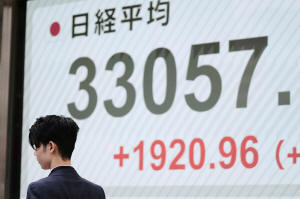World shares advance, led by 6% jump in Tokyo as markets calm somewhat
after Trump's tariff shocks
[April 08, 2025] By
ELAINE KURTENBACH
BANGKOK (AP) — World shares and U.S. futures advanced Tuesday, led by
gains in Tokyo where the Nikkei 225 shot up just over 6% as markets
calmed somewhat after the shocks from President Donald Trump ’s tariff
hikes.
The modest rebound for most markets followed a wild day on Wall Street,
where stocks careened after Trump threatened to crank his double-digit
tariffs higher.
Early Tuesday, China's Commerce Ministry said it would “fight to the
end” and take unspecified countermeasures against the United States
after Trump threatened another 50% tariff on Chinese imports.
Germany's DAX gained 0.9% to 19,975.81 while the CAC 40 in Paris was up
1.3% at 7,018.79. Britain's FTSE 100 also picked up 1.3%, to 7,804.73.
The future for the S&P 500 gained 1.5% early Tuesday while that for the
Dow Jones Industrial Average was up 1.9%.
In Tokyo, the Nikkei 225 closed a smidgen over 6% higher, at 33,012.58.
Hong Kong also recovered some lost ground, but nothing close to the
13.2% dive Monday that gave the Hang Seng its worst day since 1997,
during the Asian financial crisis.
The Hang Seng gained 1% to 20,036.03. The Shanghai Composite index
jumped 1.4% to 3,140.15 after the government investment fund Central
Huijin directed state-owned companies to help support the market with
share purchases.
South Korea’s Kospi picked up 0.3% to 2,334.23, while the S&P/ASX 200 in
Australia climbed 2.3% to 7,510.00.

Markets in Thailand and Indonesia tumbled, however, as they reopened
after holidays. Trading was suspended briefly in Jakarta when the JSX
index fell more than 9%. It was down 7.6% by mid-afternoon. Thailand’s
SET lost 4.2%.
In Taiwan, the Taiex lost 4%, pulled lower by losses for Taiwan
Semiconductor Manufacturing Corp., or TSMC, the world’s largest computer
chip maker. Its shares fell 3.8% on Tuesday.
On Monday, the S&P 500 sagged 0.2% as shell-shocked investors watched to
see what Trump will do next in his trade war. If other countries agree
to trade deals, he could lower his tariffs and avoid a possible
recession. But if he sticks with tariffs for the long haul, stock prices
may fall further.
[to top of second column] |

A man walks by monitors showing Japan's Nikkei 225 index at a
securities firm in Tokyo, Tuesday, April 8, 2025. (AP Photo/Hiro
Komae)
 The Dow sank 0.9%, and the Nasdaq
composite edged up by 0.1%.
All three indexes started the day sharply lower. But a false rumor
that Trump was considering a 90-day pause on his tariffs caused the
Dow and S&P 500 to shoot higher in the late morning. A White House
account on X quickly labeled as “fake news” the rumor that raised
hopes Trump may let up on tariffs, causing shifts in trillions of
dollars of investments.
Soon afterward, Trump dug in further, saying he may raise tariffs
more against China after the world’s second-largest economy
retaliated last week with its own set of tariffs against U.S.
products.
Trump’s trade war is an attack on the globalization that’s shaped
today's world economy and helped bring down prices but also caused
manufacturing jobs to leave for other countries.
He has said he wants to bring factory jobs back to the United
States, a process that could take years. Trump also says he wants to
narrow trade deficits with other countries, but it's unclear how
much room for negotiation there is on the U.S. side or among its
trading partners.
Indexes swung between losses and gains Monday, partly because
investors are still hoping negotiations may forestall actual
implementation of the stiff duties on all imports.
All that seemed certain Monday was the financial pain hammering
investments around the world.
Hurt by worries that a global economy weakened by trade barriers
will burn less fuel, the price of a barrel of benchmark U.S. crude
oil dipped below $60 on Monday for the first time since 2021. Early
Tuesday, it was up 67 cents at $61.37 per barrel.
Brent crude, the international standard, gained 65 cents to $64.86
per barrel.
In currency trading, the U.S. dollar fell to 147.32 Japanese yen
from 147.85 yen. The euro fell to $1.0982 from $1.0905.
The price of gold rose $54 to about $3,028.00 an ounce.
Bitcoin gained 6.2% to about $79,400. On Monday it sank below
$79,000, down from its record above $100,000 set in January.
All contents © copyright 2025 Associated Press. All rights reserved |